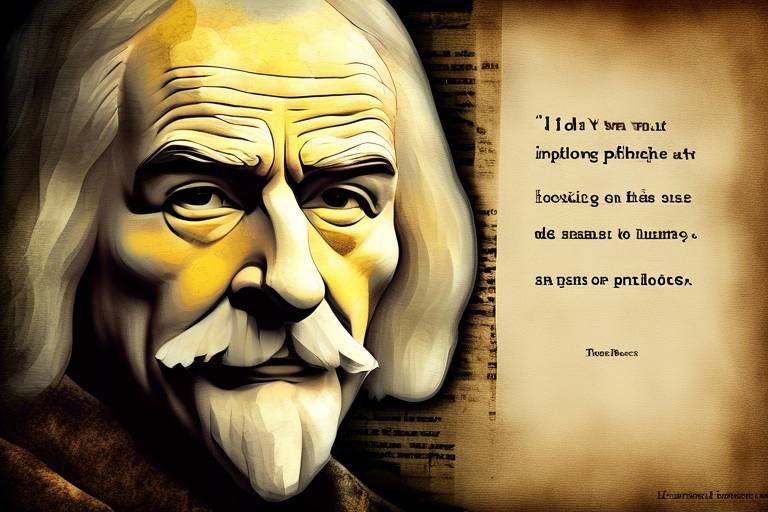How Structuralism Influences Modern Philosophy
Structuralism has emerged as a pivotal movement in the realm of philosophy, acting as a bridge between various disciplines and reshaping our understanding of meaning and culture. At its core, structuralism posits that human culture can be understood through underlying structures, akin to the rules of a game that govern how we interact with one another and the world around us. This perspective has not only influenced linguistics and anthropology but has also seeped into modern philosophical thought, challenging traditional viewpoints and encouraging a more analytical approach to understanding human experience.
Imagine walking through a vast library, each book representing a different culture, language, or philosophical idea. Structuralism is like the librarian who categorizes these books, revealing the hidden connections and frameworks that bind them together. By examining the structures that underpin language, culture, and thought, structuralism allows us to see beyond the surface and explore the intricate web of relationships that shape our reality.
One of the most compelling aspects of structuralism is its emphasis on the relational nature of meaning. Instead of viewing words and symbols as isolated entities, structuralists argue that meaning is derived from the differences and relationships between them. This revolutionary idea, introduced by thinkers like Ferdinand de Saussure, has profound implications for how we perceive language and communication. It suggests that understanding a concept requires examining its context and the other concepts it interacts with, much like understanding a character in a story necessitates knowing the plot and other characters.
As we delve deeper into the influence of structuralism, we find that it has not only transformed the landscape of philosophy but has also sparked debates and discussions that continue to resonate today. The transition from structuralism to post-structuralism, for instance, has led to critical examinations of power, identity, and the fluidity of meaning. Post-structuralist thinkers challenge the idea of fixed meanings and propose that interpretation is inherently subjective, opening the door to diverse perspectives and interpretations.
Furthermore, structuralism's impact extends into various fields, including ethics and feminist theory. By analyzing the structures that underpin societal norms and values, feminist philosophers have utilized structuralist concepts to deconstruct traditional gender roles and narratives, advocating for a more equitable understanding of identity and power dynamics. This intersection of structuralism and feminist thought exemplifies how philosophical frameworks can evolve and adapt, influencing contemporary discussions on gender and equality.
In summary, structuralism has significantly shaped modern philosophy by providing a framework for understanding the complexities of human culture and thought. Its emphasis on the relational nature of meaning and the structures that govern our experiences has opened new avenues for inquiry and debate. As we continue to explore the implications of structuralism, we are reminded that philosophy is not a stagnant field but a dynamic and evolving discourse that reflects the intricacies of human existence.
- What is structuralism? Structuralism is a theoretical framework that seeks to understand the underlying structures that shape human culture, language, and thought.
- Who are the key figures in structuralism? Prominent figures include Ferdinand de Saussure, Claude Lévi-Strauss, and Michel Foucault, each contributing significantly to the development of structuralist theory.
- How does structuralism influence modern philosophy? Structuralism has reshaped contemporary philosophical discourse by emphasizing the relational nature of meaning and the importance of underlying structures in understanding human experience.
- What is the difference between structuralism and post-structuralism? While structuralism focuses on fixed structures and relationships, post-structuralism critiques this notion, arguing that meanings are fluid and subject to interpretation.

The Foundations of Structuralism
Structuralism emerged as a powerful intellectual movement in the early 20th century, fundamentally altering the way we understand language, culture, and society. Its roots can be traced back to the fields of linguistics and anthropology, where early thinkers began to explore the underlying structures that govern human behavior and communication. At its core, structuralism posits that elements of human culture must be understood in relation to one another, rather than in isolation. This revolutionary idea set the stage for a new approach to philosophy, one that sought to uncover the invisible frameworks that shape our perceptions and experiences.
The journey of structuralism begins with the Swiss linguist Ferdinand de Saussure, whose groundbreaking work laid the foundation for modern linguistic theory. Saussure introduced the concept of the linguistic sign, which consists of two components: the signifier (the form of a word or phrase) and the signified (the concept it represents). This distinction emphasizes that meaning is not inherent in words themselves but is created through the relationships between them. His ideas highlighted how language functions as a system of differences, where the value of a word is determined by its contrast with other words.
In addition to linguistics, the influence of anthropologist Claude Lévi-Strauss cannot be overstated. He applied structuralist principles to the study of human cultures, arguing that cultural phenomena, such as myths and rituals, could be analyzed through their structural relationships. Lévi-Strauss believed that the underlying structures of thought are universal, transcending individual cultures. This perspective paved the way for a deeper understanding of how societies function and how cultural narratives are constructed. By examining the commonalities across various cultures, Lévi-Strauss demonstrated that human behavior is often governed by a set of underlying rules, much like a language.
These foundational ideas of structuralism have had a profound impact on various disciplines, including literary theory, psychology, and social sciences. Scholars began to adopt structuralist approaches to analyze texts, social practices, and even psychological constructs. For instance, in literary criticism, structuralism shifted the focus from the author’s intentions to the structures of language and narrative that shape reader interpretation. This transition marked a significant departure from traditional methods, emphasizing the importance of context and relationships over individual elements.
To summarize, the foundations of structuralism are built on the revolutionary ideas of key figures like Saussure and Lévi-Strauss, who emphasized the relational nature of meaning and the underlying structures that shape human culture. This approach has not only influenced philosophy but has also extended its reach into various fields, prompting scholars to reconsider how they analyze and interpret the world around them. The legacy of structuralism continues to resonate today, inviting new generations of thinkers to explore the intricate web of relationships that define our existence.

Key Figures in Structuralism
Structuralism, as a transformative movement in modern thought, owes much of its development to a handful of influential thinkers whose ideas continue to resonate across various disciplines. Among these pivotal figures are Ferdinand de Saussure, Claude Lévi-Strauss, and Michel Foucault. Each of these scholars contributed unique perspectives that not only shaped structuralist theory but also laid the groundwork for subsequent intellectual movements.
Ferdinand de Saussure is often regarded as the father of modern linguistics. His groundbreaking work, particularly in his book "Course in General Linguistics," introduced the concepts of the signifier and signified, fundamentally changing how we understand language. Saussure argued that meaning is not inherent in words themselves but arises from the relationships between them. This relational view is central to structuralism, emphasizing that language functions as a system of differences. To illustrate this, consider the following table that outlines the key components of Saussure's linguistic theory:
| Term | Description |
|---|---|
| Signifier | The physical form of a word or phrase (e.g., the sound or written representation). |
| Signified | The concept or meaning that the signifier represents. |
| Language as a System | A network of signs where meaning is derived from differences rather than fixed definitions. |
In addition to Saussure, Claude Lévi-Strauss brought structuralist ideas to the field of anthropology. He argued that the structures underlying human cultures could be analyzed similarly to language. Lévi-Strauss believed that myths, kinship systems, and social practices could be understood as expressions of universal structures of the human mind. His work highlighted the importance of binary oppositions—such as nature/culture and raw/cooked—as fundamental to understanding cultural narratives. This shift in perspective not only transformed anthropology but also influenced fields like literary theory and cultural studies.
Lastly, we cannot overlook the contributions of Michel Foucault. While often associated with post-structuralism, Foucault's early work was deeply rooted in structuralist principles. He explored how knowledge and power are intertwined, emphasizing that societal structures shape our understanding of truth and reality. Foucault's analysis of institutions, such as prisons and asylums, revealed the underlying structures that govern social behavior. His ideas continue to provoke thought in contemporary debates on power dynamics and social constructs.
These three thinkers—Saussure, Lévi-Strauss, and Foucault—serve as cornerstones of structuralism, each contributing to a broader understanding of how structures inform human thought and culture. Their legacies are evident in the ongoing dialogues within philosophy, linguistics, anthropology, and beyond. As we delve deeper into the influence of structuralism on modern philosophy, it's essential to recognize the foundational role these key figures play in shaping our comprehension of the world.

Ferdinand de Saussure's Linguistic Theories
Ferdinand de Saussure, a Swiss linguist, is often regarded as the father of modern linguistics, and his theories have profoundly shaped our understanding of language and its role in communication. His groundbreaking ideas emerged in the early 20th century, laying the groundwork for what would become structuralism. One of the most significant aspects of Saussure's work is his distinction between the signifier and the signified, which has become a cornerstone of linguistic theory.
To break it down, the signifier refers to the physical form of a word or phrase—the sounds or letters that make up the word. In contrast, the signified is the concept or meaning that the signifier represents. This relationship is not fixed; rather, it is relational and arbitrary. For example, the word "tree" (the signifier) evokes the image of a tall plant with leaves (the signified). This dynamic relationship underscores the idea that meaning is not inherent but constructed through social conventions.
Saussure's work emphasized that language is a system of differences. This means that the meaning of any word is derived not just from its own definition but from its contrast with other words. For instance, the meaning of "hot" is understood in relation to "cold." This relational aspect of language is crucial for understanding how we communicate and interpret meaning in various contexts. Saussure's insight into language as a system has implications that extend beyond linguistics, influencing fields such as anthropology, psychology, and philosophy.
Furthermore, Saussure introduced the idea that language is a social phenomenon. He argued that linguistic signs only gain meaning through their use within a community. This perspective challenges the notion of individual interpretation and highlights the collective nature of language. It's akin to a game where the rules are established by the players; without a shared understanding, communication would falter.
| Key Concepts | Description |
|---|---|
| Signifier | The form of a word or phrase (e.g., sounds, letters). |
| Signified | The concept or meaning represented by the signifier. |
| System of Differences | Meaning arises from the relationships between words. |
| Social Nature of Language | Meaning is constructed and understood within a community. |
In summary, Saussure's linguistic theories have not only revolutionized the study of language but have also provided a robust framework for understanding the complexities of human communication. His insights into the relational nature of meaning and the social construction of language continue to resonate in contemporary philosophy and other disciplines. By recognizing that language is more than mere words, we can appreciate the intricate web of meanings that shape our perceptions and interactions in the world.

Signifier and Signified Explained
Ferdinand de Saussure's groundbreaking linguistic theories introduced the concepts of the signifier and signified, which are fundamental to understanding how meaning is constructed in language. To put it simply, the signifier is the form that a word takes—essentially, the sound or the written word itself. For example, when we say "tree," the word "tree" is the signifier. On the other hand, the signified is the mental concept or the object that the signifier refers to; in this case, it’s the actual concept of a tree, complete with its attributes, like its trunk, branches, and leaves. This relationship is crucial because it highlights that meaning is not inherent in the word itself but is created through the relationship between the signifier and the signified.
What makes this relationship particularly fascinating is its relational nature. Saussure argued that meaning arises not from individual words in isolation but from the differences between them. For instance, the meaning of "tree" is defined not only by what it is but also by what it is not—such as "bush" or "flower." This idea can be visualized in a simple table:
| Signifier | Signified |
|---|---|
| Tree | The concept of a tree |
| Bush | The concept of a bush |
| Flower | The concept of a flower |
Furthermore, this relational aspect of language implies that meanings are not fixed; they can change over time and context. For example, the word "gay" once predominantly referred to being happy, but its signified has shifted significantly in contemporary usage. This fluidity is a key point in structuralism, emphasizing that language is a living, evolving system rather than a static collection of definitions.
Saussure's insight into language as a system of differences also extends beyond linguistics into other fields like anthropology and philosophy. It encourages us to consider how cultural and social constructs influence our understanding of the world. For instance, think about how different cultures have unique words for concepts that may not even exist in other languages. This multiplicity of meanings illustrates the complexity of human communication and perception.
In summary, the concepts of signifier and signified are not just academic jargon; they are essential tools for unraveling the intricate web of meaning that shapes our interactions and interpretations. By understanding these relationships, we can better appreciate the nuances of language and its profound impact on our thoughts and societal structures.

Language as a System
Ferdinand de Saussure introduced the revolutionary idea that language is not just a collection of words but a complex system of signs that operates through relationships. Imagine a vast web where every word is a node connected to others, forming a network of meanings. This perspective shifts our understanding of language from a mere tool for communication to a dynamic structure that shapes our thoughts and perceptions. Saussure emphasized that the meaning of a word is not inherent; instead, it is defined by its differences from other words. For instance, the word "cat" gains its significance not just from what it denotes—a furry, four-legged animal—but from its distinction from "dog," "mouse," and "feline." This relational approach is fundamental to structuralism, suggesting that language is a living entity, constantly evolving and influenced by cultural contexts.
To illustrate this concept further, consider the following table that outlines the relationships between various elements of language:
| Element | Definition | Example |
|---|---|---|
| Signifier | The form of a word or expression | "Tree" |
| Signified | The concept or meaning the signifier represents | The idea of a tree as a living organism |
| Sign | The combination of signifier and signified | The word "tree" as a complete unit of meaning |
This system of language as a network of signs leads to profound implications for understanding cultural and philosophical structures. It suggests that our thoughts and worldviews are not formed in isolation but are deeply intertwined with the linguistic systems we inhabit. For example, different languages may categorize experiences in unique ways, influencing how speakers of those languages perceive reality. This idea resonates with the Sapir-Whorf hypothesis, which posits that language shapes thought. Thus, when we analyze language as a system, we uncover the intricate ways in which it constructs our understanding of the world around us.
Moreover, Saussure’s notion of language as a system of differences invites us to explore the implications of this framework on various disciplines. In literature, for instance, understanding character motivations and themes can be enriched by examining the language used within the text. Similarly, in philosophy, the structuralist approach encourages a critical examination of how language influences concepts such as identity, ethics, and knowledge itself. This perspective not only broadens our comprehension of language but also deepens our appreciation of its role in shaping human experience.
- What is the main idea behind Saussure's theory of language? Saussure's theory posits that language is a system of signs where meaning is derived from the relationships between these signs rather than from any inherent meaning.
- How does understanding language as a system affect our perception of reality? It suggests that our understanding of reality is influenced by the linguistic structures we use, which can shape our thoughts and cultural perspectives.
- Can structuralism be applied to fields outside of linguistics? Absolutely! Structuralism has applications in various fields, including anthropology, literature, and philosophy, as it provides a framework for analyzing underlying structures in human behavior and thought.

Claude Lévi-Strauss and Anthropology
When we think about the intersection of structuralism and anthropology, one name that stands out is Claude Lévi-Strauss. This French anthropologist was a pioneering figure who took the foundational ideas of structuralism and applied them to the study of human cultures. Lévi-Strauss believed that beneath the surface of diverse cultures, there were universal structures that dictated how people think, behave, and interact. He famously stated that "the diversity of cultures is merely a surface phenomenon," suggesting that the underlying structures remain constant across different societies.
Lévi-Strauss's approach was revolutionary because it shifted the focus from individual cultural phenomena to the relationships and patterns that connect them. He argued that just as language is structured by a system of signs, so too are cultures structured by a system of myths, rituals, and social practices. This perspective opened up new avenues for understanding how cultures operate and how they can be compared. For instance, he analyzed myths from different cultures and found that they often share similar structures, which points to a common cognitive framework.
One of his most compelling contributions was the idea that human thought is fundamentally binaries. He proposed that we understand the world through oppositions, such as nature/culture, raw/cooked, and life/death. By examining these binaries, Lévi-Strauss believed we could uncover the hidden structures that shape our cultural narratives. This idea can be illustrated in the following table:
| Binary Oppositions | Examples |
|---|---|
| Nature vs. Culture | How societies view the natural world and their place within it |
| Raw vs. Cooked | Symbolizing the transformation of nature through culture |
| Life vs. Death | How different cultures understand mortality and the afterlife |
This framework not only enriched the field of anthropology but also influenced various disciplines, including literary theory, sociology, and even psychology. By recognizing that cultural phenomena are not isolated but rather interconnected, Lévi-Strauss encouraged scholars to think critically about the ways in which human beings create meaning. His work laid the groundwork for future anthropological studies that sought to explore the complexities of cultural identity and expression.
However, Lévi-Strauss's theories have not gone without critique. Some scholars argue that his emphasis on structure can overlook the dynamic and fluid nature of cultures. They contend that by focusing too much on underlying structures, we risk ignoring the historical and social contexts that shape cultural practices. Despite these criticisms, Lévi-Strauss remains a towering figure in anthropology, and his structuralist approach continues to provoke thought and discussion.
In summary, Claude Lévi-Strauss's application of structuralism to anthropology has profoundly impacted our understanding of human cultures. By revealing the universal structures that underlie cultural expressions, he challenged us to look beyond surface differences and appreciate the shared cognitive frameworks that unite us as human beings.

Structuralism in Modern Philosophy
Structuralism has profoundly influenced modern philosophy, acting as a lens through which we can examine various aspects of human thought and culture. It has reshaped our understanding of language, identity, and social structures, creating a ripple effect across numerous disciplines. But how exactly does structuralism permeate contemporary philosophical discourse? To answer this, we need to explore its relevance in key areas such as ethics, epistemology, and metaphysics.
At its core, structuralism insists that the underlying structures of human thought shape our perceptions and experiences. This isn't just a dry academic notion; it invites us to reconsider how we understand ourselves and the world around us. For instance, in ethics, structuralism challenges us to think about the frameworks that inform our moral decisions. Instead of viewing ethical dilemmas as isolated incidents, structuralists encourage us to see them as part of a larger system of beliefs and values that are interconnected.
In the realm of epistemology, structuralism posits that our knowledge is not merely a collection of facts but is structured by the language and symbols we use. This perspective leads to fascinating discussions about the nature of truth and understanding. Can we ever truly know something outside the structures that define our comprehension? This question opens the door to a rich dialogue about the limits of human knowledge and the role of language in shaping our realities.
Moreover, structuralism's impact on metaphysics cannot be overstated. It prompts us to question the very nature of existence and reality. What does it mean for something to exist if our understanding of it is mediated through language and cultural constructs? This inquiry leads to a deeper exploration of concepts like identity, agency, and the self. Are we merely products of our cultural frameworks, or do we possess an intrinsic essence that transcends these structures?
As we delve deeper into structuralism's influence, we also encounter its evolution into post-structuralism. This transition marks a significant shift in philosophical thought, where thinkers began to critique and expand upon structuralist ideas. Post-structuralists argue that meanings are not fixed but are constantly shifting, influenced by context and interpretation. This perspective introduces a dynamic element to structuralism, emphasizing the fluidity of language and meaning.
In addition to these philosophical discussions, structuralism has also made waves in the field of feminist theory. Feminist philosophers have utilized structuralist concepts to challenge traditional gender roles and narratives, arguing that societal structures often dictate our understanding of gender and identity. By deconstructing these frameworks, feminist theory seeks to unveil the underlying biases that shape our perceptions of gender, thereby advocating for a more equitable understanding of identity.
In summary, structuralism has not only influenced modern philosophy but has also sparked vibrant discussions and debates that continue to shape our understanding of various disciplines. Its relevance in ethics, epistemology, and metaphysics showcases its enduring impact, while its evolution into post-structuralism invites us to engage with the complexities of meaning and interpretation. As we navigate these philosophical waters, one thing is clear: structuralism remains a vital force in contemporary thought.
- What is structuralism? Structuralism is a theoretical framework that seeks to understand the underlying structures that shape human culture, language, and thought.
- How does structuralism influence modern philosophy? It influences modern philosophy by reshaping our understanding of ethics, epistemology, and metaphysics, emphasizing the interconnectedness of ideas and concepts.
- What is the difference between structuralism and post-structuralism? Structuralism focuses on fixed structures that govern meaning, while post-structuralism argues that meanings are fluid and context-dependent.
- How has structuralism impacted feminist theory? Structuralism has provided tools for feminist theorists to deconstruct traditional gender roles and challenge societal norms that shape our understanding of gender.

Structuralism and Post-Structuralism
The evolution from structuralism to post-structuralism marks a fascinating shift in philosophical discourse, one that has sparked heated debates and a wealth of new ideas. At its core, structuralism sought to uncover the underlying structures that govern human culture, language, and thought. Think of it as a detective peeling back the layers of a complex onion, revealing the intricate patterns that shape our understanding of the world. However, as with any great story, the plot thickens. Enter post-structuralism, which emerged as a critique and expansion of structuralist ideas, challenging the notion of fixed meanings and universal structures.
Post-structuralists argue that meanings are not static but rather fluid and contingent upon context. This perspective shifts the focus from discovering universal truths to exploring the multiplicity of interpretations and the role of power in shaping knowledge. Just like a kaleidoscope, where the images constantly shift and change, post-structuralism embraces the idea that our understanding of reality is ever-evolving. Thinkers like Jacques Derrida and Michel Foucault played pivotal roles in this transition, emphasizing how language and discourse are intertwined with power dynamics, thus complicating the structuralist framework.
One of the most significant contributions of post-structuralism is its critique of the binary oppositions that structuralism often relied upon. For example, structuralism might categorize concepts into pairs like male/female or nature/culture, suggesting a clear distinction between them. Post-structuralists, however, argue that these binaries are reductive and fail to capture the complexities of human experience. They propose a more nuanced approach that recognizes the interdependencies and overlaps between such categories, allowing for a richer understanding of identity and culture.
To illustrate this shift, consider the following table that contrasts key aspects of structuralism and post-structuralism:
| Aspect | Structuralism | Post-Structuralism |
|---|---|---|
| Meaning | Fixed and stable | Fluid and context-dependent |
| Knowledge | Universal truths | Multiple interpretations |
| Binary Oppositions | Clear distinctions | Interdependent and overlapping |
| Role of Power | Minimal emphasis | Central to understanding knowledge |
This philosophical evolution has profound implications across various disciplines, from literature and cultural studies to sociology and gender theory. It invites us to reconsider how we approach texts, cultural artifacts, and social constructs. For instance, in literature, where structuralists might focus on narrative structures, post-structuralists would encourage readers to explore how different interpretations arise and how those interpretations are influenced by cultural and historical contexts.
In summary, the transition from structuralism to post-structuralism is not merely a change in theoretical frameworks; it represents a fundamental shift in how we understand meaning, knowledge, and power. By embracing the complexities and ambiguities of human experience, post-structuralism opens up new avenues for inquiry and reflection, urging us to question the very foundations of our beliefs and assumptions.
- What is the main difference between structuralism and post-structuralism?
Structuralism seeks to identify underlying structures that govern meaning, while post-structuralism emphasizes the fluidity of meaning and the influence of context and power. - Who are some key figures in post-structuralism?
Notable thinkers include Jacques Derrida, Michel Foucault, and Julia Kristeva, all of whom contributed significantly to the development of post-structuralist thought. - How does post-structuralism influence contemporary philosophy?
Post-structuralism encourages a more nuanced understanding of identity, culture, and knowledge, challenging rigid categorizations and promoting diverse perspectives.

Impact on Feminist Theory
Structuralism has had a profound impact on feminist theory, serving as a crucial framework for understanding and deconstructing traditional gender roles and narratives. At its core, structuralism posits that human culture is shaped by underlying structures that dictate how we interpret our experiences. This perspective allows feminist theorists to analyze the societal constructs surrounding gender, revealing how these constructs are not inherent but rather socially constructed and maintained.
One of the key contributions of structuralism to feminist theory is the idea of language as a tool for shaping reality. Feminist theorists have adopted Ferdinand de Saussure's notion of the signifier and signified to explore how language influences our perception of gender. For instance, the way we talk about women in literature and media often reflects and reinforces stereotypes. By analyzing these linguistic structures, feminists can unveil the biases embedded in language and challenge the narratives that perpetuate inequality.
Furthermore, structuralism encourages a critical examination of the binary oppositions that often underpin societal norms. In many cultures, gender is viewed through a binary lens—male/female, strong/weak, rational/emotional. Feminist theorists have utilized structuralist principles to deconstruct these binaries, arguing that they limit our understanding of gender and do not reflect the complexities of human identity. This deconstruction allows for a more nuanced view of gender, recognizing that individuals may embody traits from both sides of the binary or exist outside of it altogether.
Additionally, structuralism has influenced feminist theory by highlighting the role of power dynamics in shaping gender relations. Thinkers like Michel Foucault have explored how power operates within societal structures, and feminist theorists have applied these insights to understand how patriarchal systems maintain control over women's bodies and identities. This analysis reveals that the fight for gender equality is not merely about achieving equal rights but also about dismantling the structures that uphold gendered power imbalances.
In practical terms, the influence of structuralism can be seen in various feminist movements and discourses. For example, the concept of intersectionality, which acknowledges that individuals experience multiple, overlapping identities, can be traced back to structuralist ideas. Feminists recognize that gender does not exist in isolation from other social categories such as race, class, and sexuality. By understanding these intersections, feminists can advocate for a more inclusive approach to gender equality that addresses the unique challenges faced by marginalized groups.
In conclusion, the impact of structuralism on feminist theory is both profound and multifaceted. By providing a framework for analyzing the structures that shape our understanding of gender, structuralism has equipped feminist theorists with the tools needed to challenge traditional narratives and advocate for a more equitable society. As feminist theory continues to evolve, the insights derived from structuralism will undoubtedly remain a vital component of the discourse.
- What is structuralism? Structuralism is an intellectual movement that seeks to understand the underlying structures that shape human culture, language, and thought.
- How has structuralism influenced feminist theory? Structuralism has provided feminist theorists with tools to analyze and deconstruct traditional gender roles, emphasizing the social construction of gender and the importance of language in shaping perceptions.
- What role does language play in feminist theory? Language is seen as a powerful tool that can reinforce or challenge societal norms. Feminists analyze language to uncover biases and stereotypes related to gender.
- What is intersectionality in feminist theory? Intersectionality is the concept that individuals experience overlapping identities, such as race, class, and gender, which intersect to create unique experiences of oppression or privilege.

Critiques of Structuralism
While structuralism has undeniably shaped modern philosophy and various disciplines, it is not without its critics. Detractors argue that structuralism's emphasis on underlying structures often overlooks the complexities of human experience and cultural nuances. This critique suggests that by focusing too heavily on abstract structures, structuralism risks reducing rich, multifaceted realities into overly simplistic models. For instance, some philosophers contend that structuralism's reliance on binary oppositions can lead to a rigid understanding of culture and society, failing to account for the fluidity and dynamism of human interactions.
Moreover, critics highlight that structuralism tends to prioritize the system over the individual. This perspective can lead to a depersonalization of cultural phenomena, where individual agency and subjective experiences are overshadowed by overarching structures. In a world where personal narratives and lived experiences are increasingly recognized as vital for understanding social dynamics, this limitation of structuralism becomes even more apparent.
Another significant critique stems from the rise of post-structuralism, which emerged as a response to the perceived shortcomings of structuralism. Post-structuralist thinkers argue that meaning is not fixed but is instead fluid and constantly evolving. They challenge the idea that structures can fully encapsulate the complexities of language and culture, suggesting instead that meaning is shaped by context, power dynamics, and historical contingencies. This shift has led to a more nuanced understanding of texts and cultural artifacts, emphasizing the importance of interpretation and the role of the reader or viewer.
Furthermore, structuralism has also faced challenges from feminist theorists who argue that its frameworks often neglect the gendered dimensions of culture. While structuralism seeks to identify universal structures, feminist critiques assert that such an approach can obscure the ways in which gender operates within these structures, leading to an incomplete analysis of social phenomena. Feminists advocate for a more intersectional approach that considers how various identities—such as race, class, and gender—interact with structural forces.
To summarize the critiques of structuralism, we can look at some key points:
- Oversimplification: Critics argue that structuralism reduces complex human experiences to simplistic models.
- Depersonalization: The focus on systems may overshadow individual agency and subjective experiences.
- Fluidity of Meaning: Post-structuralism emphasizes that meaning is not fixed but rather fluid and context-dependent.
- Gender Blindness: Structuralism may overlook the gendered dimensions of cultural analysis.
In conclusion, while structuralism has made significant contributions to philosophy and social sciences, it is essential to engage critically with its limitations. Understanding these critiques allows scholars and practitioners to refine their approaches, ensuring that the complexities of human experience are not lost in the search for underlying structures. As we move forward in contemporary discourse, integrating insights from both structuralism and its critiques can lead to a richer, more comprehensive understanding of culture, language, and society.
Q: What is structuralism?
A: Structuralism is an intellectual movement that focuses on understanding the underlying structures that shape human culture, language, and thought. It emphasizes the relationships between elements within a system rather than the elements themselves.
Q: Who are some key figures in structuralism?
A: Prominent figures include Ferdinand de Saussure, who contributed to linguistics; Claude Lévi-Strauss, known for his work in anthropology; and Michel Foucault, who explored the relationship between power and knowledge.
Q: What are the main critiques of structuralism?
A: Critics argue that structuralism oversimplifies complex human experiences, depersonalizes cultural analysis, and often neglects the fluidity of meaning and the gendered dimensions of culture.
Frequently Asked Questions
- What is structuralism and how did it originate?
Structuralism is a theoretical paradigm that emerged in the early 20th century, primarily from the fields of linguistics and anthropology. It focuses on understanding the underlying structures that govern human culture and thought. The origins can be traced back to the linguistic theories of Ferdinand de Saussure, who emphasized the relational nature of language and meaning.
- Who are the key figures associated with structuralism?
Some of the most influential figures in structuralism include Ferdinand de Saussure, Claude Lévi-Strauss, and Michel Foucault. Saussure's ideas laid the groundwork for understanding language, while Lévi-Strauss applied structuralism to anthropology, and Foucault explored its implications in social theory and philosophy.
- How does structuralism influence modern philosophy?
Structuralism has significantly impacted contemporary philosophical discourse by shaping discussions in ethics, epistemology, and metaphysics. It challenges traditional views by encouraging a focus on the structures that inform human experience and knowledge, leading to new ways of understanding various philosophical issues.
- What is the difference between structuralism and post-structuralism?
While structuralism seeks to identify and analyze the underlying structures of culture and thought, post-structuralism critiques these ideas, arguing that meaning is always shifting and context-dependent. Post-structuralist thinkers build upon structuralist concepts but emphasize the fluidity and instability of meaning.
- In what ways has structuralism influenced feminist theory?
Structuralism has provided feminist theorists with tools to analyze and deconstruct traditional gender roles and narratives. By understanding the underlying structures that shape societal norms, feminist philosophy can challenge and reshape these narratives, promoting a more equitable perspective.
- What are some critiques of structuralism?
Critiques of structuralism often focus on its perceived limitations, such as its tendency to overlook individual agency and the complexity of human experience. Some philosophers argue that structuralism's emphasis on overarching structures can lead to a deterministic view of culture and thought, prompting the development of alternative frameworks that prioritize individual perspectives.



















